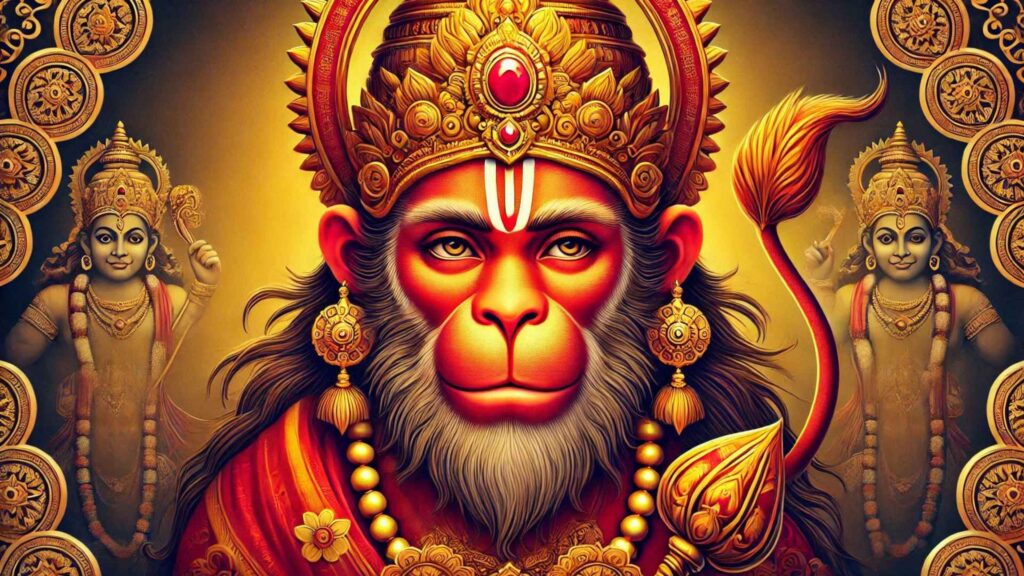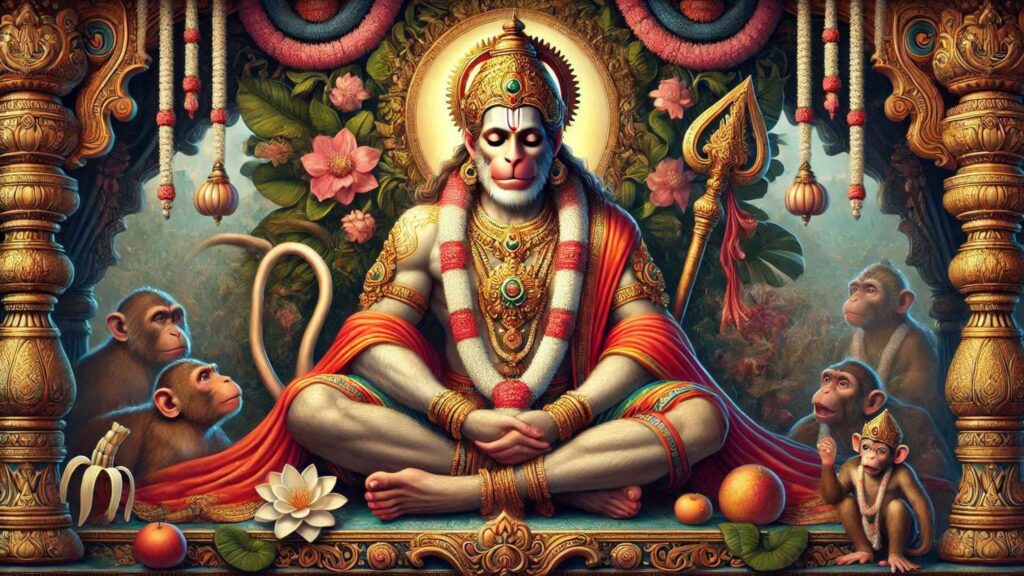Lord Hanuman: The Eternal Devotee and Embodiment of Strength
Introduction
Lord Hanuman, one of the most revered deities in Hinduism, is known for his unparalleled devotion to Lord Rama and his immense physical and spiritual strength. As the son of Vayu (the wind god) and Anjana, Hanuman is celebrated as a symbol of courage, loyalty, and humility. His tales of bravery, wisdom, and devotion inspire millions across the world.
Read More About Deities And Gods
In daily Hindu life, Hanuman is worshipped as the remover of obstacles and protector from evil forces. His stories, especially from the Ramayana, continue to serve as a moral compass, teaching the values of service, faith, and selflessness.
Significance of Lord Hanuman in Hinduism
In Daily Hindu Life
Hanuman is a guardian deity, invoked for protection, courage, and victory over challenges. Devotees often chant the Hanuman Chalisa and visit Hanuman temples to seek his blessings. He is particularly venerated on Tuesdays and Saturdays, which are considered auspicious for his worship.
Cosmic and Spiritual Importance
Hanuman represents the ideal devotee and the infinite potential of the human spirit when aligned with divine will. His devotion to Lord Rama symbolizes the path of bhakti (devotion), while his immense strength and wisdom represent the balance of physical and spiritual power.
Names and Etymology

Meaning of Hanuman
The name “Hanuman” is derived from Sanskrit, where “Hanu” means jaw, and “man” signifies disfigured. The name refers to an incident in his childhood when his jaw was struck by Lord Indra’s thunderbolt.
Other Names of Hanuman and Their Significance
- Anjaneya: Son of Anjana, highlighting his divine lineage.
- Bajrangbali: One with a strong body like lightning, symbolizing his immense physical power.
- Pavanputra: Son of Vayu, representing his swiftness and ability to transcend limits.
- Kesari Nandan: Son of Kesari, his earthly father, showcasing his connection to the mortal realm.
- Mahavira: The great hero, reflecting his bravery and courage.
Each name emphasizes different aspects of his divine personality and attributes.
Symbolism and Iconography

Physical Description of Hanuman
Lord Hanuman is often depicted as a monkey-faced deity with a muscular body, carrying a gada (mace) and a mountain in one hand. His glowing aura and humble posture reflect both his strength and devotion.
Symbolism
- Monkey Form: Represents purity, innocence, and a mind focused on divine service.
- Gada (Mace): Symbolizes his strength and commitment to protect Dharma.
- Carrying the Mountain: Reflects his dedication and resourcefulness in fulfilling his duties.
- Tail: Represents his dynamic energy and unwavering loyalty.
Flower Connection
The marigold is often associated with Hanuman, symbolizing energy, positivity, and devotion.
Colors and Symbols
- Orange and Red: Represent his fiery energy, strength, and spiritual vibrance.
- Sacred Thread: Reflects his adherence to dharma and spiritual discipline.
Mythology and Stories

Birth Story
Hanuman was born to Anjana, a celestial nymph cursed to live on earth, and Kesari, a monkey king. Vayu, the wind god, played a crucial role in his birth, making Hanuman his spiritual son and endowing him with extraordinary strength and speed.
Connection with Other Gods
- Lord Rama: Hanuman is Rama’s most devoted follower, symbolizing unconditional service and love.
- Lord Shiva: Hanuman is considered an incarnation of Shiva, reflecting his divine energy.
- Vayu: As the wind god’s son, he possesses unmatched agility and vitality.
Role in the Ramayana
Hanuman’s role in the Ramayana is central. From leaping across the ocean to Lanka, locating Sita, and burning Lanka with his tail, to bringing the Sanjeevani herb to save Lakshmana, Hanuman exemplifies devotion, courage, and selflessness.
Famous Blessings and Boons
Hanuman was blessed with immortality and invincibility by the gods. He is revered as a protector, ensuring the well-being of those who seek his blessings.
Spiritual Significance
A Visible Form of God
Hanuman is worshipped as a living deity who continues to protect and guide his devotees. His form inspires faith, strength, and humility.
Representation of Knowledge and Enlightenment
Hanuman’s wisdom and intellect are as celebrated as his physical prowess, representing the ideal balance of mind and body.
Connection to Spiritual Awakening
Through his unwavering devotion to Rama, Hanuman symbolizes the transformative power of bhakti and the ability to overcome ego and ignorance.
Role in Yoga and Meditation
Hanuman is linked to pranayama (breathing exercises) and energy regulation, representing control over the body and mind.
The Mantra Connection
A popular mantra for Hanuman is:
“Om Hanumate Namah”
This mantra invokes his blessings for strength, courage, and protection.
The Hanuman Chalisa, composed by Tulsidas, is a revered hymn recited to honor Hanuman and seek his divine grace.
Worship and Rituals
Benefits of Worship
- Removes obstacles and fears.
- Brings courage, strength, and clarity.
- Ensures protection from negative energies.
Daily Worship Practices
- Offering sindoor (vermilion) and marigold flowers.
- Lighting a diya (lamp) and chanting his mantras.
- Reciting the Hanuman Chalisa.
Significance of Day
Tuesdays and Saturdays are especially dedicated to Hanuman worship, with devotees fasting and performing special prayers.
Important Festivals
- Hanuman Jayanti: Celebrates his birth.
- Rama Navami: Highlights his role in Lord Rama’s life.
Famous Temples
- Hanuman Temple, Connaught Place, Delhi.
- Sankat Mochan Temple, Varanasi.
- Mahavir Mandir, Patna.
- Jakhoo Temple, Shimla.
Modern Relevance
Scientific Understanding
Hanuman’s attributes, such as strength and devotion, serve as metaphors for psychological resilience and mental fortitude.
Environmental Consciousness
Hanuman’s association with nature and his role in protecting Rama’s mission reflect the importance of harmony with the environment.
Health Benefits
Chanting Hanuman mantras is believed to reduce stress, enhance focus, and promote mental and physical well-being.
Cultural Impact
Influence on Indian Art and Architecture
Hanuman is a prominent figure in temple sculptures, paintings, and folklore, symbolizing strength and devotion.
Presence in Literature and Poetry
From the Ramayana to the Hanuman Chalisa, Hanuman’s tales inspire devotion and moral values in Hindu literature.
Impact on Daily Customs
Hanuman’s image and mantras are used for protection, positivity, and overcoming challenges.
Regional Variations in Worship
- North India: Focus on his role in the Ramayana.
- South India: Worshipped as Anjaneya with unique rituals and traditions.
Practical Applications
Morning Prayers and Rituals
Starting the day with Hanuman mantras brings strength and clarity.
Dietary Recommendations
Following a sattvic (pure) diet during Hanuman worship fosters discipline and spiritual focus.
Astrological Significance
Hanuman’s blessings are sought to mitigate the malefic effects of Saturn (Shani) and other planetary afflictions.
Gemstones and Metals
Red coral and copper are associated with Hanuman’s energy and vitality.
Conclusion
Lord Hanuman epitomizes strength, devotion, and the boundless potential of the human spirit. His teachings inspire us to overcome challenges, remain humble, and serve selflessly. Worshipping Hanuman fosters courage, clarity, and a deep connection to the divine.


